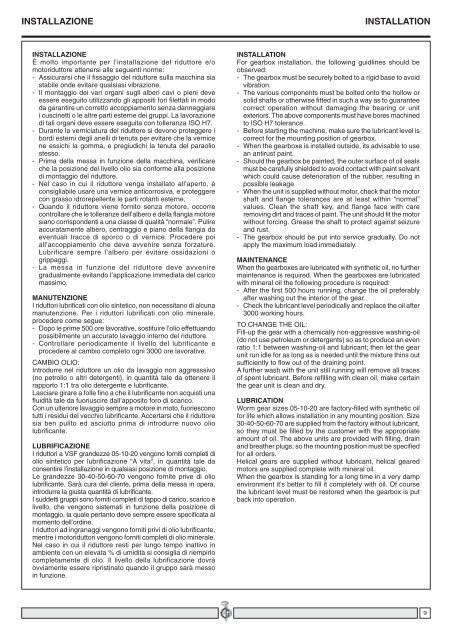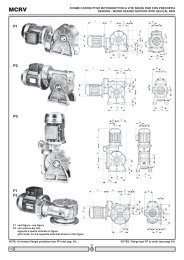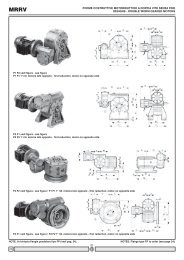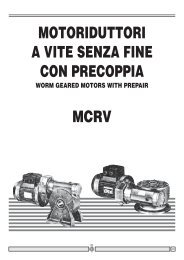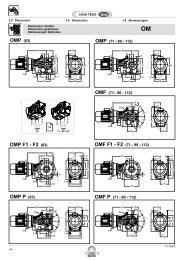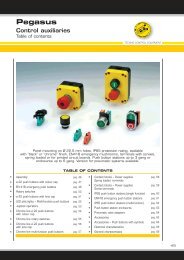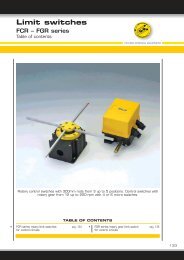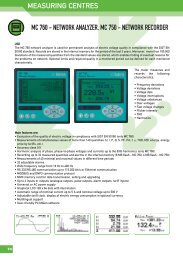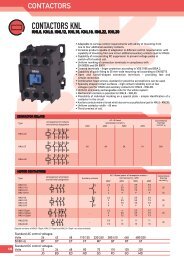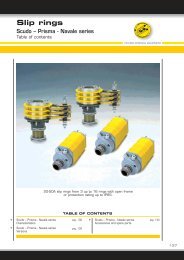catalogo generale n. 10 - Transmo
catalogo generale n. 10 - Transmo
catalogo generale n. 10 - Transmo
Create successful ePaper yourself
Turn your PDF publications into a flip-book with our unique Google optimized e-Paper software.
INSTALLAZIONE<br />
INSTALLATION<br />
INSTALLAZIONE<br />
È molto importante per l’installazione del riduttore e/o<br />
motoriduttore attenersi alle seguenti norme:<br />
- Assicurarsi che il fissaggio del riduttore sulla macchina sia<br />
stabile onde evitare qualsiasi vibrazione.<br />
- Il montaggio dei vari organi sugli alberi cavi o pieni deve<br />
essere eseguito utilizzando gli appositi fori filettati in modo<br />
da garantire un corretto accoppiamento senza danneggiare<br />
i cuscinetti o le altre parti esterne dei gruppi. La lavorazione<br />
di tali organi deve essere eseguita con tolleranza ISO H7.<br />
- Durante la verniciatura del riduttore si devono proteggere i<br />
bordi esterni degli anelli di tenuta per evitare che la vernice<br />
ne essichi la gomma, e pregiudichi la tenuta del paraolio<br />
stesso.<br />
- Prima della messa in funzione della macchina, verificare<br />
che la posizione del livello olio sia conforme alla posizione<br />
di montaggio del riduttore.<br />
- Nel caso in cui il riduttore venga installato all’aperto, è<br />
consigliabile usare una vernice anticorrosiva, e proteggere<br />
con grasso idrorepellente le parti rotanti esterne.<br />
- Quando il riduttore viene fornito senza motore, occorre<br />
controllare che le tolleranze dell’albero e della flangia motore<br />
siano corrispondenti a una classe di qualità “normale”. Pulire<br />
accuratamente albero, centraggio e piano della flangia da<br />
eventuali tracce di sporco o di vernice. Procedere poi<br />
all’accoppiamento che deve avvenire senza forzature.<br />
Lubrificare sempre l’albero per evitare ossidazioni o<br />
grippaggi.<br />
- La messa in funzione del riduttore deve avvenire<br />
gradualmente evitando l’applicazione immediata del carico<br />
massimo.<br />
MANUTENZIONE<br />
I riduttori lubrificati con olio sintetico, non necessitano di alcuna<br />
manutenzione. Per i riduttori lubrificati con olio minerale,<br />
procedere come segue:<br />
- Dopo le prime 500 ore lavorative, sostituire l’olio effettuando<br />
possibilmente un accurato lavaggio interno del riduttore.<br />
- Controllare periodicamente il livello del lubrificante e<br />
procedere al cambio completo ogni 3000 ore lavorative.<br />
CAMBIO OLIO:<br />
Introdurre nel riduttore un olio da lavaggio non aggresssivo<br />
(no petrolio o altri detergenti), in quantità tale da ottenere il<br />
rapporto 1:1 tra olio detergente e lubrificante.<br />
Lasciare girare a folle fino a che il lubrificante non acquisti una<br />
fluidità tale da fuoriuscire dall’apposito foro di scarico.<br />
Con un ulteriore lavaggio sempre a motore in moto, fuoriescono<br />
tutti i residui del vecchio lubrificante. Accertarsi che il riduttore<br />
sia ben pulito ed asciutto prima di introdurre nuovo olio<br />
lubrificante.<br />
LUBRIFICAZIONE<br />
I riduttori a VSF grandezze 05-<strong>10</strong>-20 vengono forniti completi di<br />
olio sintetico per lubrificazione “A vita”, in quantità tale da<br />
consentire l’installazione in qualsiasi posizione di montaggio.<br />
Le grandezze 30-40-50-60-70 vengono fornite prive di olio<br />
lubrificante. Sarà cura del cliente, prima della messa in opera,<br />
introdurre la giusta quantità di lubrificante.<br />
I suddetti gruppi sono forniti completi di tappo di carico, scarico e<br />
livello, che vengono sistemati in funzione della posizione di<br />
montaggio, la quale pertanto deve sempre essere specificata al<br />
momento dell’ordine.<br />
I riduttori ad ingranaggi vengono forniti privi di olio lubrificante,<br />
mentre i motoriduttori vengono forniti completi di olio minerale.<br />
Nel caso in cui il riduttore resti per lungo tempo inattivo in<br />
ambiente con un elevata % di umidità si consiglia di riempirlo<br />
completamente di olio. Il livello della lubrificazione dovrà<br />
ovviamente essere ripristinato quando il gruppo sarà messo<br />
in funzione.<br />
INSTALLATION<br />
For gearbox installation, the following guidlines should be<br />
observed:<br />
- The gearbox must be securely bolted to a rigid base to avoid<br />
vibration.<br />
- The various components must be bolted onto the hollow or<br />
solid shafts or otherwise fitted in such a way as to guarantee<br />
correct operation without damaging the bearing or unit<br />
exteriors. The above components must have bores machined<br />
to ISO H7 tolerance.<br />
- Before starting the machine, make sure the lubricant level is<br />
correct for the mounting position of gearbox.<br />
- When the gearboxe is installed outside, its advisable to use<br />
an antirust paint.<br />
- Should the gearbox be painted, the outer surface of oil seals<br />
must be carefully shielded to avoid contact with paint solvant<br />
which could cause deterioration of the rubber, resulting in<br />
possible leakage<br />
- When the unit is supplied without motor, check that the motor<br />
shaft and flange tolerances are at least within “normal”<br />
values. Clean the shaft key, and flange face with care<br />
removing dirt and traces of paint. The unit should fit the motor<br />
without forcing. Grease the shaft to protect against seizure<br />
and rust.<br />
- The gearbox should be put into service gradually. Do not<br />
apply the maximum load immediately.<br />
MAINTENANCE<br />
When the gearboxes are lubricated with synthetic oil, no further<br />
maintenance is required. When the gearboxes are lubricated<br />
with mineral oil the following procedure is required:<br />
- After the first 500 hours running, change the oil preferably<br />
after washing out the interior of the gear.<br />
- Check the lubricant level periodically and replace the oil after<br />
3000 working hours.<br />
TO CHANGE THE OIL:<br />
Fill-up the gear with a chemically non-aggressive washing-oil<br />
(do not use petroleum or detergents) so as to produce an even<br />
ratio 1:1 between washing-oil and lubricant; then let the gear<br />
unit run idle for as long as is needed until the mixture thins out<br />
sufficiently to flow out of the draining point.<br />
A further wash with the unit still running will remove all traces<br />
of spent lubricant. Before refilling with clean oil, make certain<br />
the gear unit is clean and dry.<br />
LUBRICATION<br />
Worm gear sizes 05-<strong>10</strong>-20 are factory-filled with synthetic oil<br />
for life which allows installation in any mounting position. Size<br />
30-40-50-60-70 are supplied from the factory without lubricant,<br />
so they must be filled by the customer with the appropriate<br />
amount of oil. The above units are provided with filling, drain<br />
and breather plugs, so the mounting position must be specified<br />
for all orders.<br />
Helical gears are supplied without lubricant, helical geared<br />
motors are supplied complete with mineral oil.<br />
When the gearbox is standing for a long time in a very damp<br />
environment it’s better to fill it completely with oil. Of course<br />
the lubricant level must be restored when the gearbox is put<br />
back into operation.<br />
9


